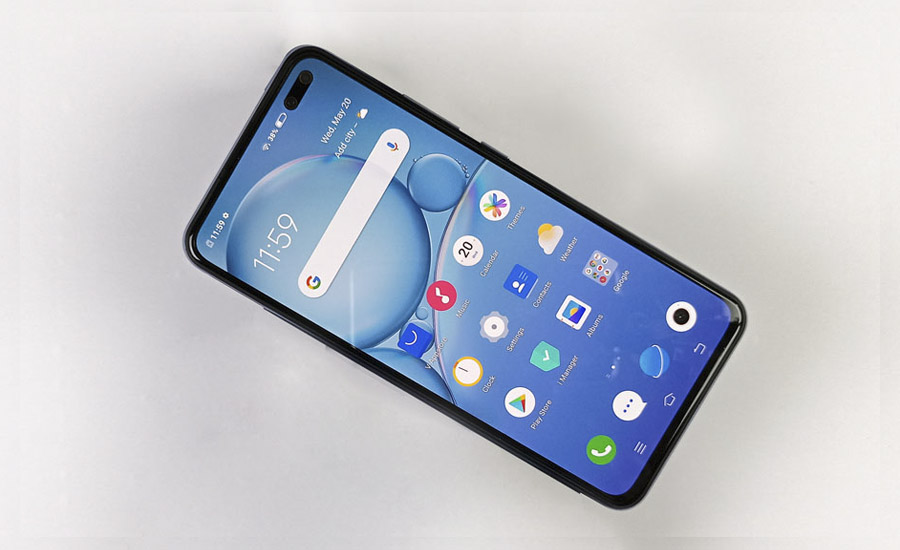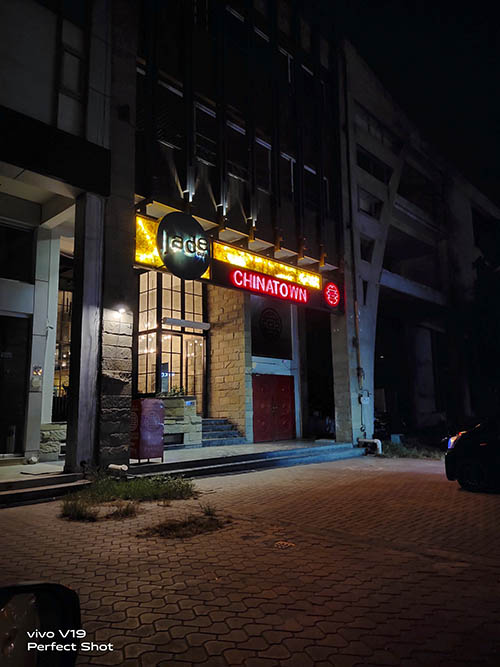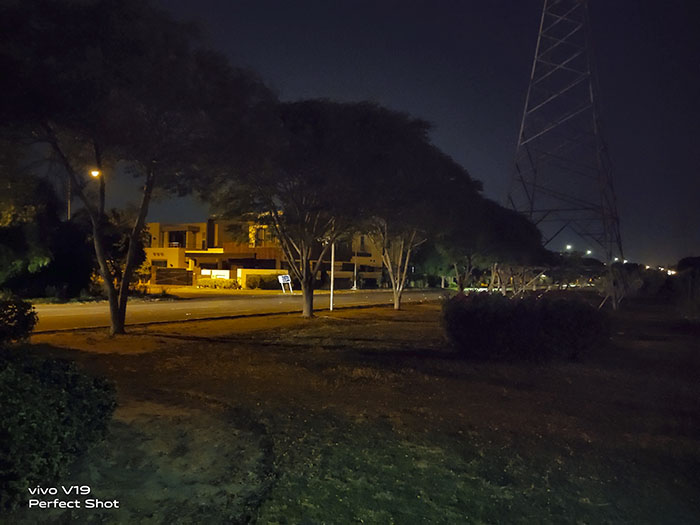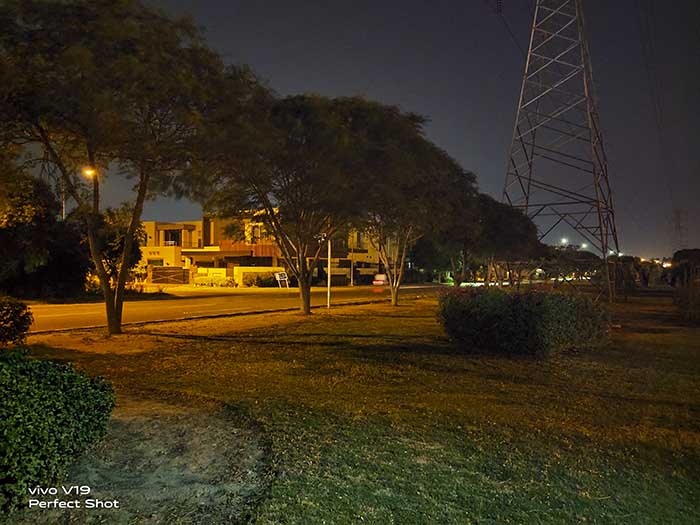The illustrious Vivo V series has always focused all of its energies on perfecting the art of night photography. With Vivo V17, the company pushed us into a new array by allowing us to see in the dark but this time they are confident about outshining their old achievement with the help of Vivo V19 whose slogan reads “Ignite your night.”
The new addition to the Vivo V series comes with a dual selfie camera at the front, a feature we saw last year in the Pro variant of Vivo V17. Surely, the additional camera will help improve bokeh selfies for base-variant users. One of the stand-out features of this series has always been the good battery life and with Qualcomm’s 7 series chipset, we expect Vivo V19 to show exceptional performance as well as a long-lasting battery. So, does this new smartphone delivers on its promises? Let’s find out:
Design and Display
The Chinese smartphone giant has been putting a lot of effort into improving the design of its smartphones and Vivo V19 is a testament to the fact. It is a sleek-looking device that comes with a glass body at the front and back. Our review unit was in Mystic Silver color and its rear side could also serve as a mirror, a practical feature especially when you wanna check up on your looks in the middle of the workday or at a party.
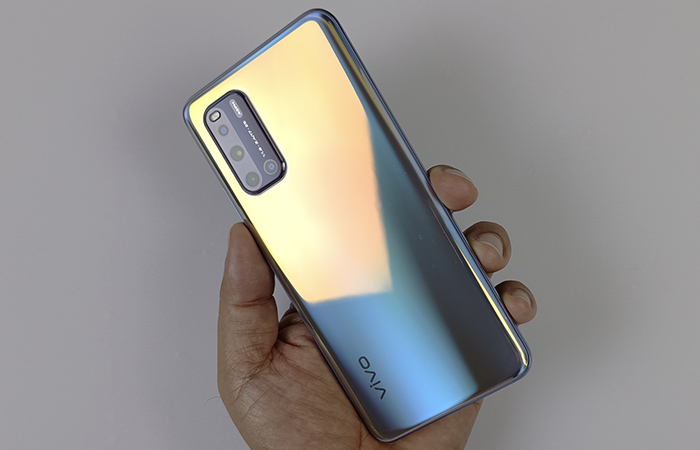
The glass body undoubtedly gives a chic and premium feeling to the smartphone but on the downside, it becomes a fingerprint magnet and you might have to sacrifice showing off your device by enveloping it in a phone case. At the front, the dual camera takes up a lot of space, pushing the battery icon away from its original place.
The new arrangement though looks unusual, is not too odd once you get used to it. However, the notifications bar area does look a bit overcrowded as the company has tried to squeeze in too many icons in a smaller space.
The smartphone offers 6.4 inches of Super AMOLED display which comes with 2400 x 1080 pixels of screen resolution. Satisfactorily, with Vivo V19 we get a pretty crisp and colorful display and when it comes to the phone’s brightness, you don’t even have to cross the mid-level mark to lit up your screen indoors.
For outdoor activities, the phone is bright enough to let you see the content on the screen without any hassle. Furthermore, there are no issues with the side-viewing angles of the phone and the big screen really brings the most out of the graphics especially for gamers.
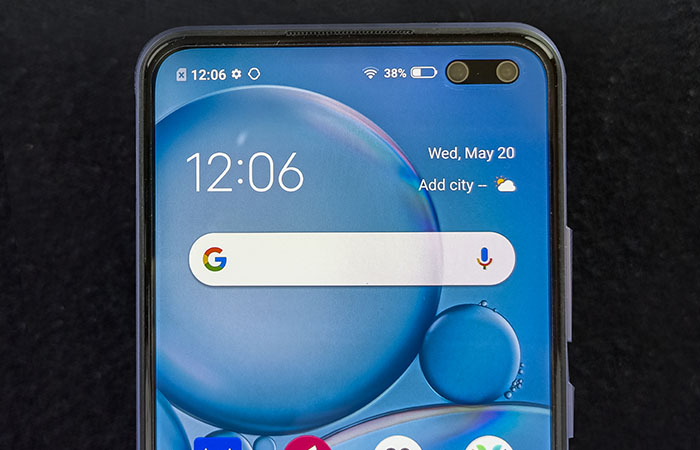
Performance
The smartphone is equipped with Qualcomm Snapdragon 712 chipset which is accompanied by 8GB RAM, 128GB of internal storage, and Android 10-based Funtouch OS 10. On the Antutu benchmark, Vivo V19 scored 238710, on the other hand, smartphones with Qualcomm Snapdragon 720G have scored considerably better on the same benchmark like Redmi Note 9S and Redmi Note 9 Pro which scored 279314 and 265930 respectively.
Moreover, Huawei Nova 7i with Kirin 810 chipset also scored more as compared to Vivo’s new device i.e. 294377.
With Vivo V19, you can play PUBG in HD graphics and at a high frame rate, giving a smooth gaming experience to the users. We also discovered no lags or frame drops while testing the smartphone. The sound, on the other hand, is not one of the best features of this device. Although the phone’s single firing speaker produces good high and low-frequency sounds, it is not loud enough and you’ll need to plug in your earphones to consume multimedia.
The device also comes with ear-customized sound effects, replacing the option to customize the sound settings. This feature is enabled by default and can assess and administer the sound quality depending upon the user’s hearing capability.
Though initially it looked a little unfriendly for the consumers and took a little more time as compared to the uncomplicated equalizer option, we ended up really enjoying the high-quality sounds playing through the earphones. But, we do believe that the company should have kept the usual sound settings besides the new sound assessing tool and leave the choice at the user’s discretion.
User Interface
If you are using Vivo’s new smartphone after making a jump from Stock Android then you may find Functouch OS 10 a bit too complex but if you stick to it a bit longer you will find that it is one of the most customizable operating systems in the market at the moment. The improved OS is all about creating shortcuts of the frequently done tasks and keeping them a single tap away from the users.
By swiping right on the home screen, you will come face to face with the Smart Launcher featuring a pile of cards that lets you access everyday information. Another convenient tool called Easy Touch will stick to your screen and by simply tapping on it you can see a selection of pre-selected apps and tools which can be added or removed by the user.
Vivo’s AI assistant Jovi is also getting smarter as it can keep a track of the daily usage pattern and provide a summary to help improve the user’s daily wellbeing by summing up how much time they spent on individual apps, etc. We believe it is an extension of the Android-provided digital wellbeing feature which is present in almost all phones today.
Battery
When it comes to battery life, Vivo smartphones can be relied upon to provide long-lasting power and keep us connected on the go. We have been quite amazed by the battery optimization provided by the Chinese smartphone giant ever since we tested Vivo S1 Pro and this time with Vivo V19, the firm has not let us down.
Check out our ranking of the best mobile phones with the longest battery life
The device comes with FlashCharge 2.0 and a 33W charger right out of the box. It took 1 hour and 33 mins to fully charge the smartphone and in our video loop test, Vivo V19 completely discharged its battery in 17 hours and 38 mins. Alas, the phone couldn’t outperform the Vivo S1 Pro that played a video for 19 hours 14 mins in a loop before running out of charge.
In the 4 hours of real-life usage test, the phone consumed 42% battery. If you are an avid PUBG player, you should expect a loss of 16-18% of battery in an hour-long gaming session. Similarly, video recording also drains around 18-19% of battery in an hour even if you are not using the phone’s flash
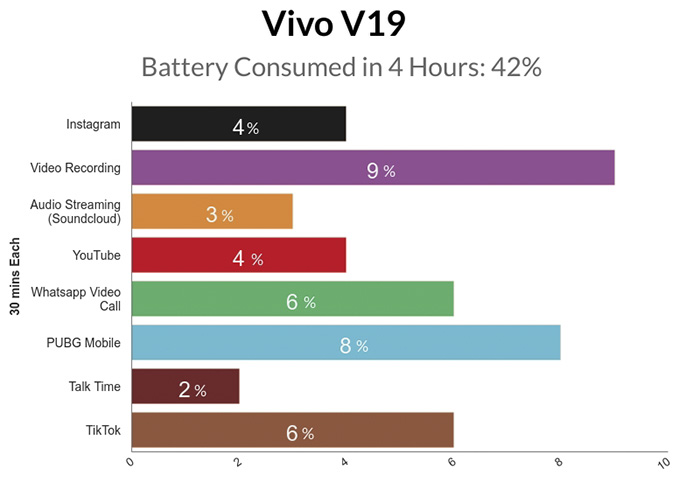
Camera
Vivo V19 is equipped with a 48MP main camera, a feature that is common in many smartphones coming nowadays. The device also has an 8MP ultrawide lens, 2MP bokeh lens, and 2MP macro sensor. We believe that the company should have upgraded the 2MP macro lens to a 5MP one as we have seen the latter in comparatively low-priced Xiaomi Redmi Note 9S and Redmi Note 9 Pro. For selfies, the smartphone also features 32MP main and 8MP ultrawide lenses at the front.
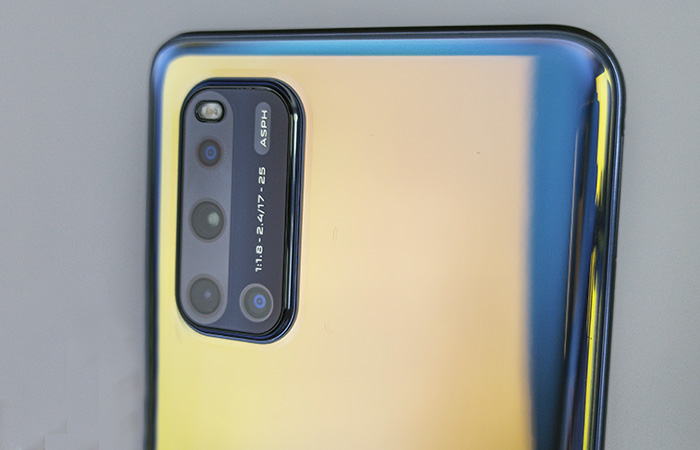
The default camera app of the smartphone comes with tons of interesting features for the users. Vivo’s Jovi intelligence can prove to be a helpful guide as it can adjust the phone’s camera settings to suit different scenarios. The company has also poured a lot of effort into perfecting the beauty mode as the smartphone offers a huge variety of options to tweak different attributes of the subject. While we are quite satisfied with the interface of the app, we do believe that there is potential to further simplify it for a convenient photographic experience.
While testing the camera of the smartphone, it was interesting to see that all the lenses behaved differently when it came to color reproduction. The phone performed exceptionally well especially during sunlight and captures natural colors in the standard mode (12MP mode) and keeps the noise well under control in the photograph. Also, the dynamic range looks adequate enough to highlight the presence of dark objects in the image.

The 48MP mode can shoot bigger images but they seem like they have undergone some kind of treatment. We can notice that the saturation is higher as compared to the standard mode. As you can see in the image below, the cloudy sky looks more bluish in the picture taken in 48MP mode while the 12MP mode replicated the actual scenario.

Another shot taken a few seconds later turned the bluish sky into a grey one.

Furthermore, the images taken with 48MP mode show a lot more noise as compared to the pictures taken by 12MP mode which provides more details of the subject.

But, if the subject is well-lit during the day (more sunlight), the noise does not become too much of a hindrance while using a 48MP mode.

As the smartphone comes with the Super AMOLED screen, you cannot discern all the differences in the different images as they all show crisp colors but you can spot the changes while looking at all the shots on the computer.
The HDR mode of Vivo V19 also does a tremendous job as you can see in the images below; the standard mode has blown out the details of the image whereas HDR mode has added more depth to the scenery.

Though the HDR mode adds a yellowish tint in the image, it does show more details of the subject as compared to the standard mode. The Pro mode, on the other hand, allows the user to tweak and play around with a number of settings. You have the option to shoot in raw format which will create an additional image with a .dng extension. This format helps to store a lot of raw information about the image which can help in the editing process. The pro mode also takes jpg and .dng shots using 48MP mode.

The 8MP super-wide-angle lens can take some decent shots that are well-detailed as well as quite colorful.

The bokeh and macro shots are surprisingly quite up to the mark in the daylight. We can see that the edge detection in the two modes is very clean and the blurred areas show no noise at all.

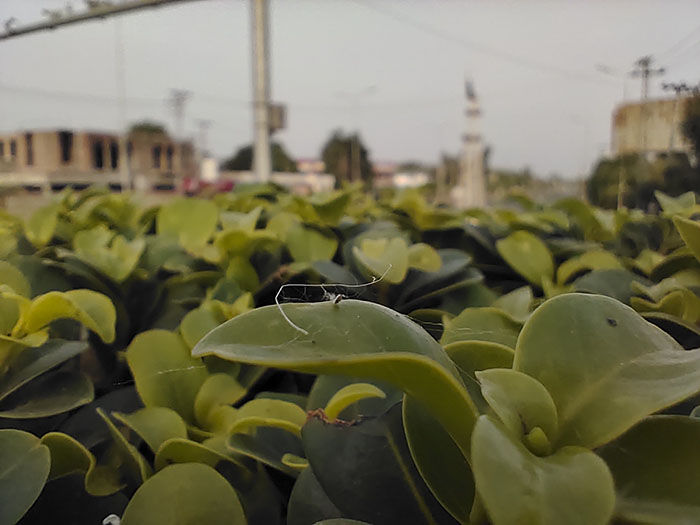
Vivo V19 did exceptionally well in night photography as well especially in the presence of ambient light. All three modes including standard, HDR, and night mode show almost similar results. If you look at the following images, you can see that the images taken with HDR mode and the night mode show almost the same details, colors, and contrast.
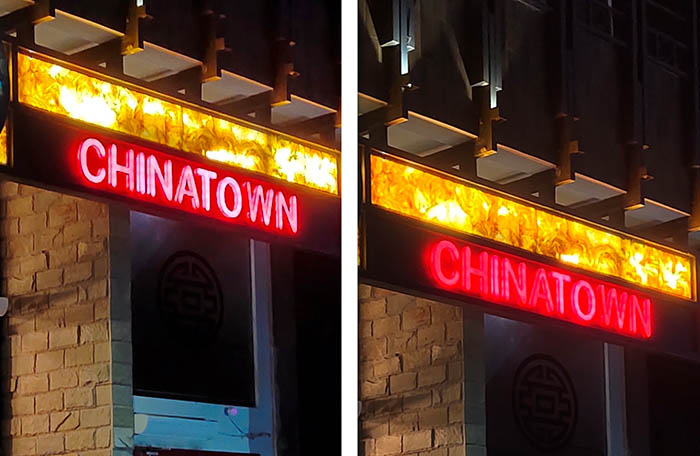
We also noticed that in a few instances the HDR mode produced softer and less detailed images at night. So, if you are taking images in low-lit areas, using night mode will be your safest bet to get a good picture.
Vivo V series has never disappointed us in the selfie department and Vivo V19 is no exception. The phone allowed us to take nicely exposed images at night even in the low-lit and dark areas, quite unlike the selfies produced by many new phones at night time.
The 32MP front camera uses the screen flash to light up the scenario and can do a good job both indoors and outdoors. The camera’s noise suppression mechanism is very good and we do not see an annoying amount of noise even in the dark areas.
The default selfie mode comes with some preset beauty enhancement tools which can be further customized in the beauty mode which can tweak even the shape of the face as well as the body. It won’t be wrong to say that Vivo V19 can serve as a digital makeover tool for portrait and selfie lovers.
The smartphone can also use the front camera to record up to 1080p videos and the rear camera to tape 4K videos but for the latter, the ultra-stable mode only works with 720p videos.
The phone also has a marvelous feature called Art Mode that records video by either blurring the background (bokeh effect in 720p) or converting it into black and white (monochrome) and works with both front and back cameras. Vivo V19 can also shoot 120 and 240fps slow-mo videos
Final Verdict
Vivo V19 is an exceptional smartphone and directly competes with two other prominent devices of 2020, OPPO Reno 3 Pro and Samsung Galaxy A71. When it comes to beauty, Vivo has the upper hand as the exquisite design of V19 looks splendid in one’s hands. Though all three phones have capable cameras, Vivo V19 again takes the lead with its impressive selfie shooter which can take well-exposed images even in the dark.
Vivo’s smartphone also offers an exciting Art Mode feature for video recording that can skillfully blur the background as well as turn it into monochrome. Although OPPO Reno 3 Pro does allow the user to blur the background in their videos (bokeh mode), the edge detection and the blurring effect are not as good as what we experienced in V19.
In the performance category, all three smartphones perform exceptionally well as they come with powerful chipsets but when it comes to battery, Galaxy A71 does a slightly better job than Vivo V19 as it took 1 hour and 25 mins to fully charge and 18 hours and 27 mins to completely discharge.
Looking at the above-mentioned facts, we believe that the newest addition to the Vivo V series excels in most of the categories and is a suitable alternative for both OPPO Reno 3 Pro and Samsung Galaxy A71.
Alternative
If you are willing to spend some more money, you can find much better performance, battery, and camera in the Samsung Galaxy A71 regardless of the fact that it struggles to handle light sources while taking pictures at night. OPPO Reno 3 Pro, which is closer to Vivo V19 in price, is also a great option that can fully charge the device from 0 to 100% in only 53 mins but on the downside consumes battery a little faster than what we have seen in many other phones.

